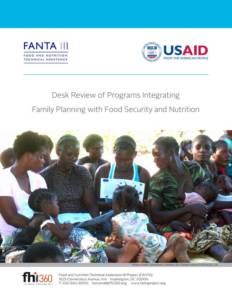Integrating Family Planning in Food Security and Nutrition Programmes
USAID desk review of programmes integrating family planning with food security and nutrition
Research focus
How do food security and nutrition programmes integrate family planning across the health sector and multisectoral programmes?
Main findings
Integrated family planning is often part of a larger health programme when it comes to maternal, newborn, and child health, integrated management of childhood illnesses, or food security and livelihood packages. Potential practices for integration of family planning are targeting the 1,000-day window, conducting home visits, and also engaging men.
Family planning interventions include education, counselling, provision of contraceptive commodities, or referral to these services. A programme had an integrated programming if the interventions were delivered at the same contact/entry point or by the same provider.
The paper describes sector related service delivery findings, models of integration and platforms as well as providers for integrated service delivery. It also discusses promising practices for programming and gives recommendations that are not applicable to USAID only.
In addition, the study analyses methods and models in detail by having a close look on the Live Long Child Programme in Burundi to fight childhood diseases, a food assistance programme in Haiti and the Community Markets for Conservation Programme in Zambia focusing on environmentally destructive livelihoods.
Download
The study is available at Food and Nutrition Technical Assistance (FANTA). Case studies are available separately.


